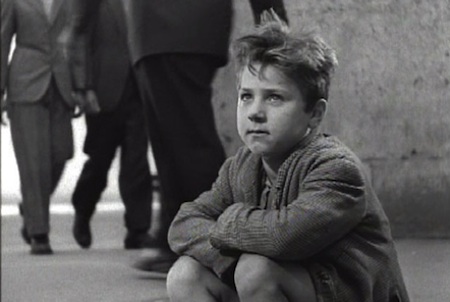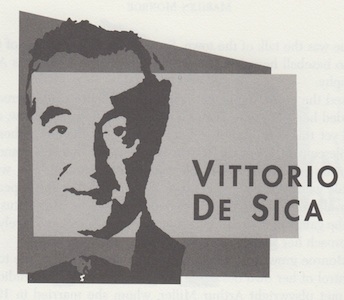Born: July 7, 1901, Sora, Italy
Died: November 13, 1974, Paris, France
A filmmaker who was clearly more experienced and, indeed, more interested and skillful in penetrating the depths of individual psychological reactions than Rossellini.
—Bosley Crowther
Roberto Rossellini’s classic Open City (1946) is frequently considered the first film in the Italian neorealistic movement, a postwar period of experimental film that was characterized by the resourcefulness of its directors, who shot on the streets, used ordinary people as actors and focused on the dramatic situations commonly found in daily life. Rossellini’s work is complex and gritty, but many purists cite the work of Vittorio De Sica as the truest representation of the genre. Certainly, De Sica’s films became the popular favorites, changing the face of films entirely and casting the director as a central figure in Italian films.
The handsome Vittorio De Sica began as an actor, first appearing in the sound film Vecchia Signora (1931). He used his good looks to surprising success as a matinee idol in Italy, and his countenance graced more then 150 Italian films, as well as plenty of teenage gossip magazines. After graduating from light comedies during World War II, De Sica, like Rossellini, made realistic films that reflected the social tragedies of postwar Italy. His poignant movies were emotional plays about downtrodden people struggling to keep their faith in the goodness of man.
The first of such films, The Children Are Watching Us (1942), shaped Italian film production by rejecting most of Hollywood’s conventions. These films were made in collaboration with scriptwriter Cesare Zavattini, a major proponent of realism in film. Zavattini’s scenarios eschewed trite or clever story devices, focused on working-class settings, and were emotionally charged. To carry these values through, De Sica hired untrained actors and shot on the streets. The film was welcomed enthusiastically by audiences in impoverished Rome.
De Sica’s next film, Shoeshine (1946), established him as the “artist of the poor.” The deceptively simple story is about young street urchins hustling stolen blankets in an effort to buy a horse. They wind up in a reformatory where they experience corruption and dehumanization. The plain narrative style of the story powerfully illuminated the social injustices in European societies after the war. Umberto D. (1952) was an ambitious comment on the problems of old age, but audiences found it too bleak and it was a financial disaster at the box office. However, De Sica’s attempts to combine a documentary feel with sophisticated elements of humor were generally considered important. These techniques became the focus of the French New Wave directors, who studied what they called “cinema verité,” the cinema of truth. De Sica’s work had a major impact on their films, notably in the stark feel of Jean-Luc Godard’s Breathless (1959).
The height of this truth-telling neorealism movement was De Sica’s The Bicycle Thief (1949), arguably the most popular Italian film ever made. It is a touchstone of its kind, telling the story of a poor man whose relationship with his son is tested following the theft of a bicycle. Filmed with studio techniques, it had a fresh, improvisational quality. To heighten emotion, De Sica compressed scenes to their core feelings. All of the action takes places on the back streets of Rome, away from the beautiful fountains and piazzas the city is famous for; instead, these are the dirty and crowded buildings where laundry hangs from windows, people toss their garbage in the gutter and those without jobs hang around in doorways staring at passing strangers. The film achieves an air of authenticity by cutting actual documentary footage into some segments, a technique found today in the films of Spike Lee and Oliver Stone. The film is prominently ranked in almost every film critic’s annual poll of all-time greats and was extremely influential, especially among directors; the Indian director Satyajit Ray, who saw the film as a young boy visiting Rome, credits it with compelling him to become a filmmaker, and Woody Allen called it an example of near-perfect film direction. De Sica received international acclaim and awards, including an Oscar for Best Foreign Film.
De Sica continued acting to finance some of his own projects; he directed Sophia Loren and Marcello Mastroianni in Yesterday, Today and Tomorrow (1964). Vittorio De Sica made twenty-five films in his career and received four Academy Awards, including an Oscar for The Garden of the Finzi-Continis (1971), which is not regarded as a neorealist work. His methods made others aware of the beauty that can be plainly captured through the lens.
To read all the republished articles from ‘The Film 100,’ go to Reintroducing the Film 100 here on Keyframe.





